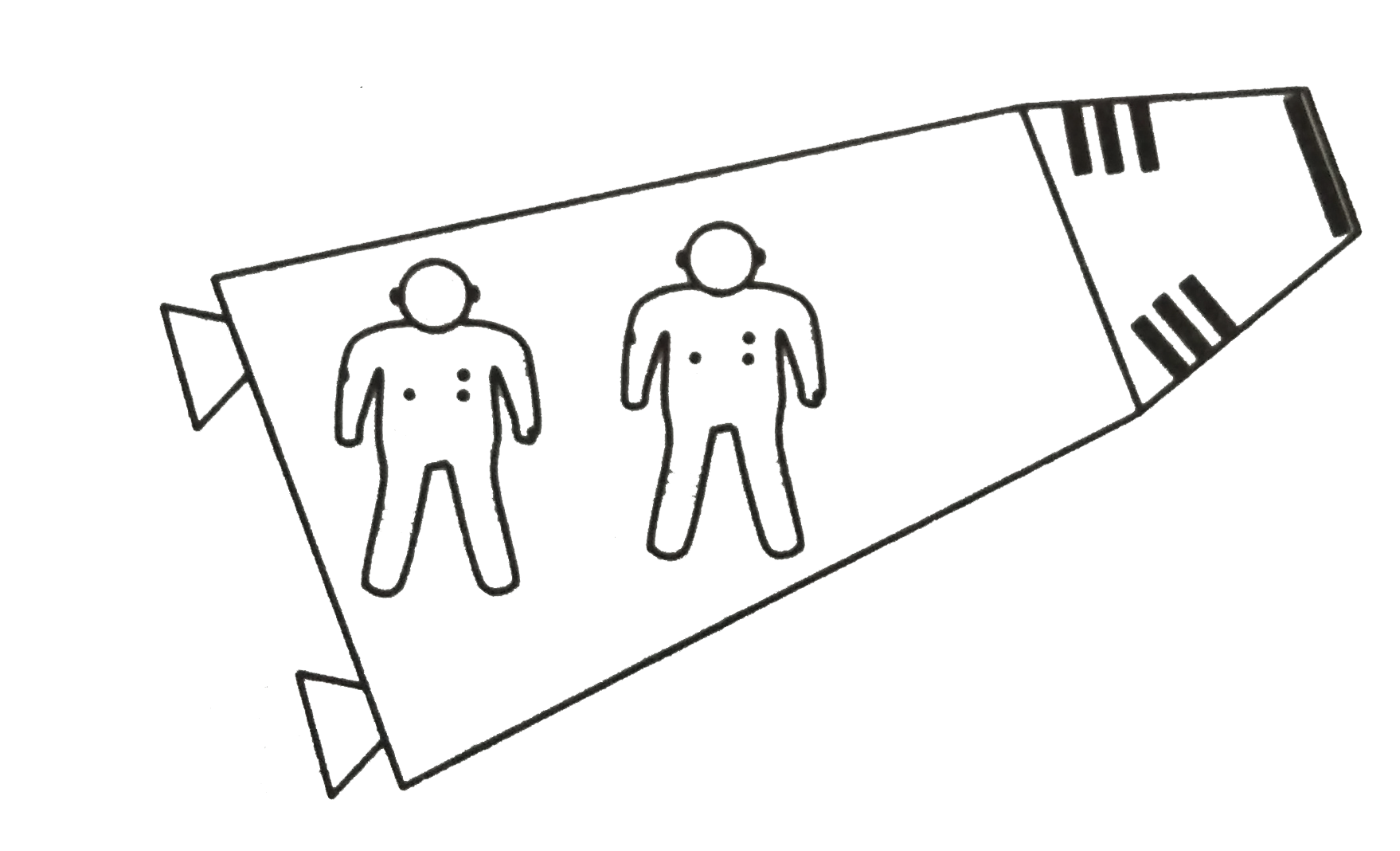A 1 kg stationary bomb is exploded in three parts having mass 1 : 1 : 3 respectively. Parts having same mass move in perpendicular direction with velocity 30ms–1, then the velocity of bigger part will be : -
10√2ms−1
10√2ms−1
15√2ms−1
15√2ms−1
The correct Answer is:A
To solve the problem step by step, we will use the principle of conservation of momentum. Here's the detailed solution:
Step 1: Understand the Problem
We have a bomb with a total mass of 1 kg that explodes into three parts with mass ratios of 1:1:3. The two smaller parts (each of mass 0.2 kg) move in perpendicular directions with a velocity of 30 m/s. We need to find the velocity of the larger part (mass 0.6 kg).
Step 2: Determine the Masses
Given the mass ratio of 1:1:3, we can denote the masses as:
- Mass of part 1 (m1) = x
- Mass of part 2 (m2) = x
- Mass of part 3 (m3) = 3x
The total mass is:
m1+m2+m3=x+x+3x=5x=1 kg
Thus, we find:
x=15=0.2 kg
So, the masses are:
- m1 = 0.2 kg
- m2 = 0.2 kg
- m3 = 0.6 kg
Step 3: Set Up the Momentum Conservation Equation
Since the bomb is initially stationary, the initial momentum is zero. After the explosion, the momentum must also equal zero:
0=m1⋅v1+m2⋅v2+m3⋅v3
Where:
- v1 and v2 are the velocities of the two smaller parts,
- v3 is the velocity of the larger part.
Step 4: Assign Directions to the Velocities
Assume:
- Part 1 moves in the positive x-direction: v1=30m/s^i
- Part 2 moves in the positive y-direction: v2=30m/s^j
Step 5: Substitute Values into the Momentum Equation
Substituting the values into the momentum equation:
0=(0.2⋅30^i)+(0.2⋅30^j)+(0.6⋅v3)
This simplifies to:
0=6^i+6^j+0.6v3
Step 6: Rearranging the Equation
Rearranging gives:
0.6v3=−6^i−6^j
Thus:
v3=−6^i−6^j0.6
v3=−10^i−10^j
Step 7: Calculate the Magnitude of the Velocity
The magnitude of v3 is given by:
|v3|=√(−10)2+(−10)2
|v3|=√100+100=√200=10√2m/s
Step 8: Conclusion
The velocity of the larger part is 10√2m/s in the direction opposite to the resultant of the two smaller parts.
We have a bomb with a total mass of 1 kg that explodes into three parts with mass ratios of 1:1:3. The two smaller parts (each of mass 0.2 kg) move in perpendicular directions with a velocity of 30 m/s. We need to find the velocity of the larger part (mass 0.6 kg).
Given the mass ratio of 1:1:3, we can denote the masses as:
- Mass of part 1 (m1) = x
- Mass of part 2 (m2) = x
- Mass of part 3 (m3) = 3x
m1+m2+m3=x+x+3x=5x=1 kg
Thus, we find:
x=15=0.2 kg
So, the masses are:
- m1 = 0.2 kg
- m2 = 0.2 kg
- m3 = 0.6 kg
Since the bomb is initially stationary, the initial momentum is zero. After the explosion, the momentum must also equal zero:
0=m1⋅v1+m2⋅v2+m3⋅v3
- v1 and v2 are the velocities of the two smaller parts,
- v3 is the velocity of the larger part.
Assume:
- Part 1 moves in the positive x-direction: v1=30m/s^i
- Part 2 moves in the positive y-direction: v2=30m/s^j
Substituting the values into the momentum equation:
0=(0.2⋅30^i)+(0.2⋅30^j)+(0.6⋅v3)
This simplifies to:
0=6^i+6^j+0.6v3
Rearranging gives:
0.6v3=−6^i−6^j
Thus:
v3=−6^i−6^j0.6
v3=−10^i−10^j
The magnitude of v3 is given by:
|v3|=√(−10)2+(−10)2
|v3|=√100+100=√200=10√2m/s
The velocity of the larger part is 10√2m/s in the direction opposite to the resultant of the two smaller parts.
Similar Questions
A body of mass explodes at rest break up into three parts.If two parts having equal masses fly off perpendicularly to each other with a velocity of 18m/s, then calculate the velocilty of the third part which has a mass 3 times the mass of each part.
View SolutionA particle of mass 1mg has the same wavelength as an electron moving with a velocity of 3×106ms−1. The velocity of the particle is
View Solution
Knowledge Check
1 kg body explodes into three fragements. The ratio of their masses is 1:1:3. The fragments of same mass move perpendicular to each other with speed 30 m/s. The speed of heavier part is
A10√2 m/sB10√2 m/sC20√2 m/sD30√2 m/s
A body of mass 1kg initially at rest, explodes and breaks into three fragments of masses in the ratio 1:1:3. The two pieces of equal mass fly off perpendicular to each other with a speed of 15ms−1 each. What is the velocity of the heavier fragment?
View SolutionA man of mass 62 kg is standing on a stationary boat of mass 238 kg. The man is carrying a sphere of mass 0.5 kg in his hands. If the man throws the sphere horizontally with a velocity of 12 ms−1, find the velocity with which the boat will move (in magnitude)
View SolutionA block at rest explodes into three equal parts. Two parts start moving along X and Y axes respectively with equal speeds of 10 m/s. Find the initial velocity of the third part.

View SolutionA stationary particle explodes into two particles of masses x and y, which move in opposite directions wit h velocity v1andv2. The ratio of their kinetic energies (E1:E2) is
View SolutionA body of mass 1kg initially at rest explodes and breaks into threee fragments of masses in the ratio 1:1:3. The two pieces of equal masses fly off perpendicular to each other with a speed of 30m/s each What is the velocity of heavier fragments ? .
View SolutionA stationary particle explodes into two particle of a masses m1andm2 which move in opposite direction with velocities v1andv2. The ratio of their kinetic energies E1/E2 is
View SolutionA body of mass M moves in outer space with vleocity v. It is desired to break the body into two parts so that the mass of one part is one-tenth of the total mass. After the explosion, the heavier part comes to rest whole the lighter part continues to move in the original direction of motion. The velocity of the small part will be
View Solution